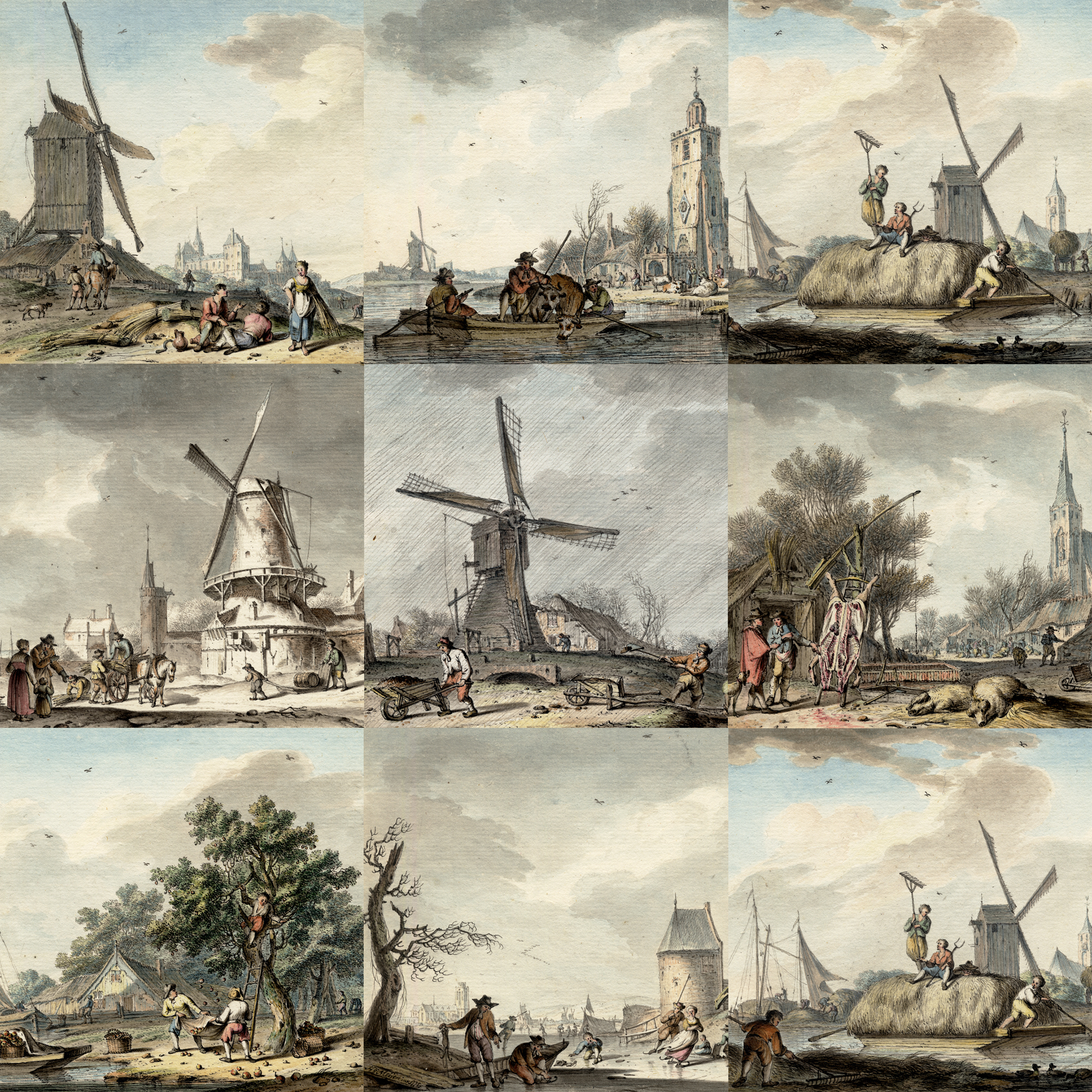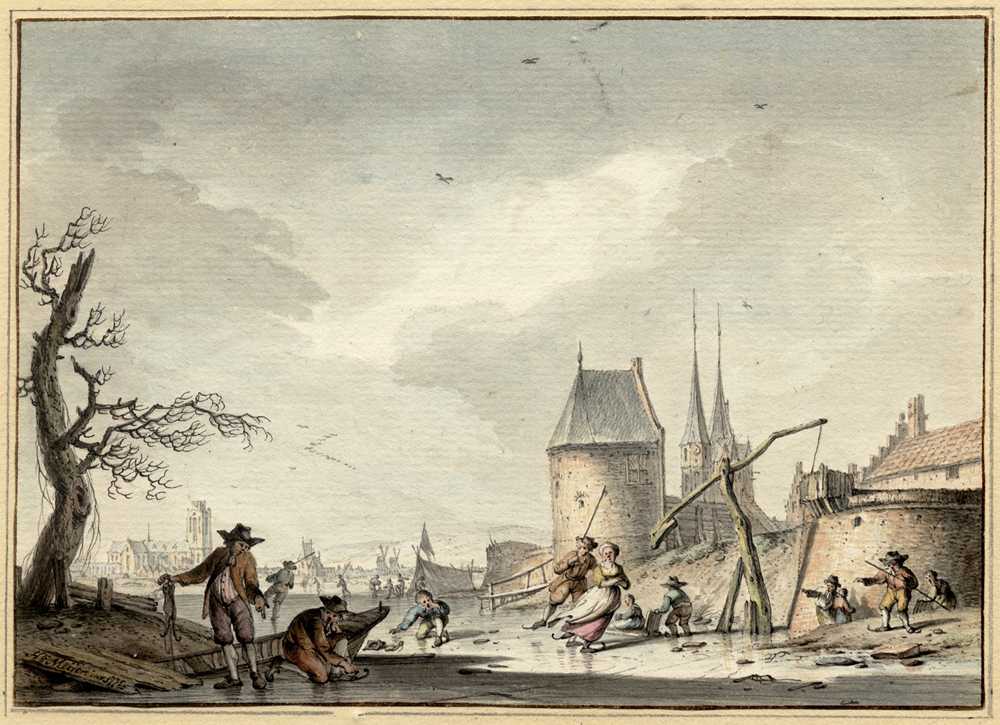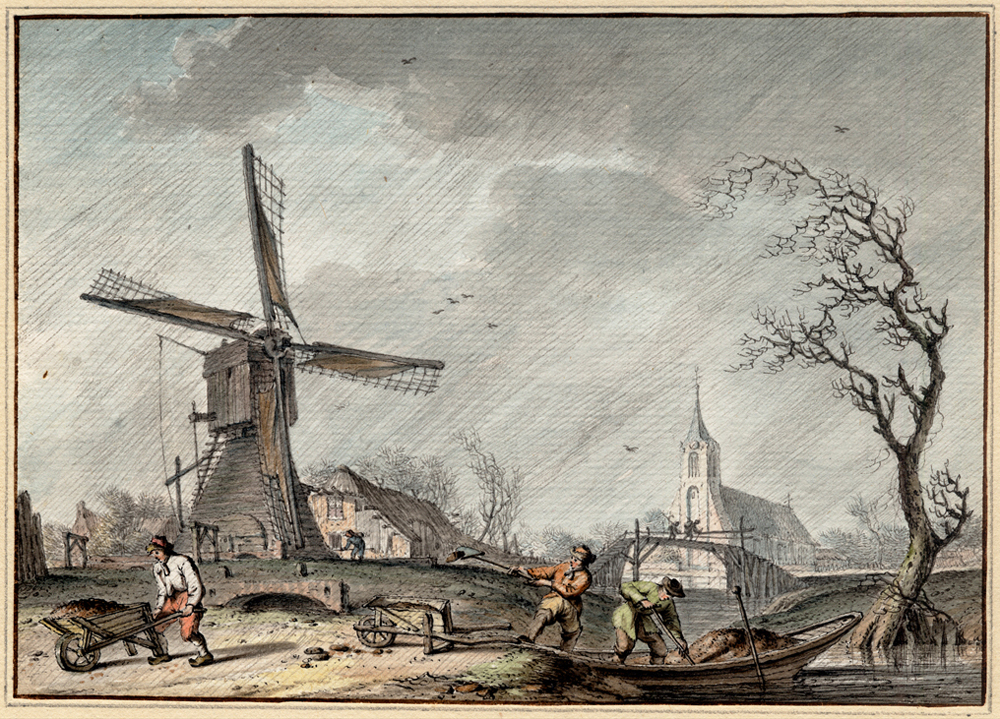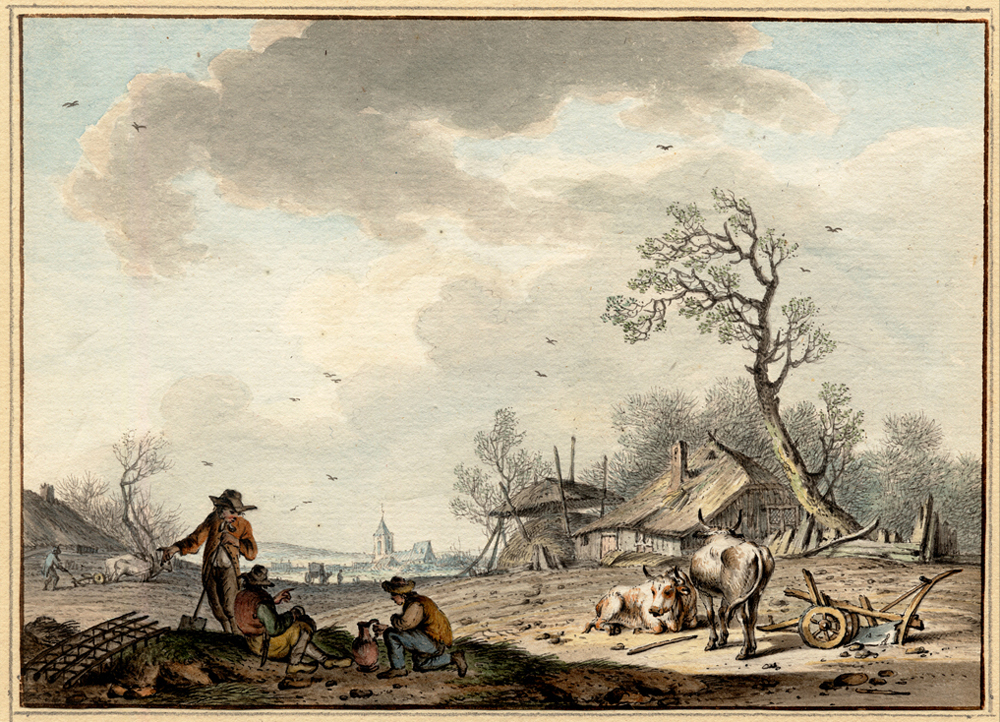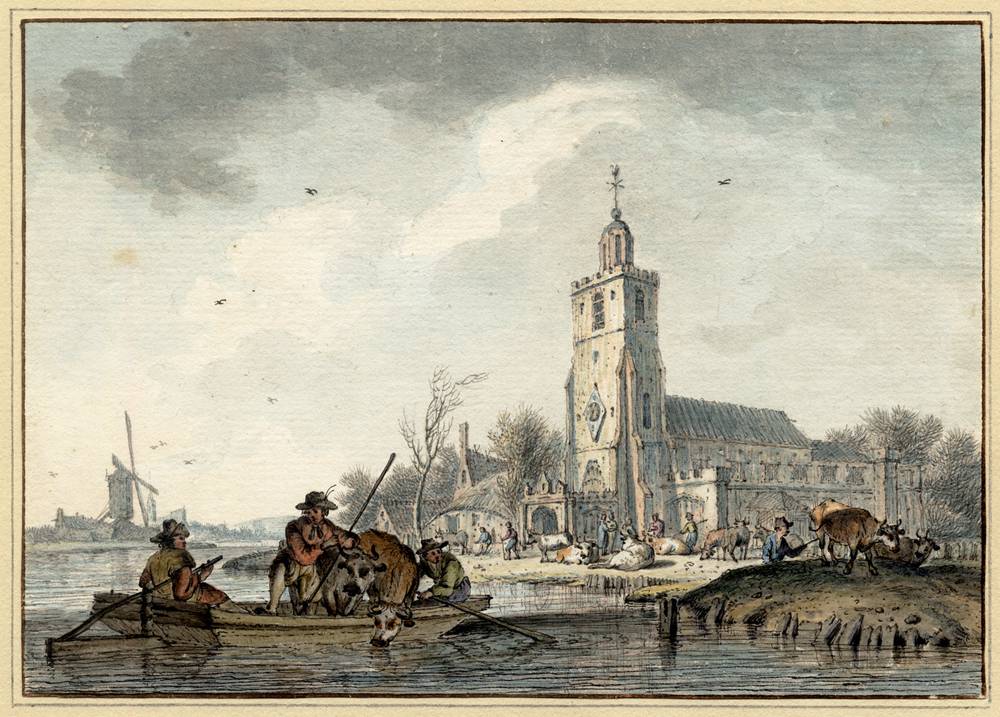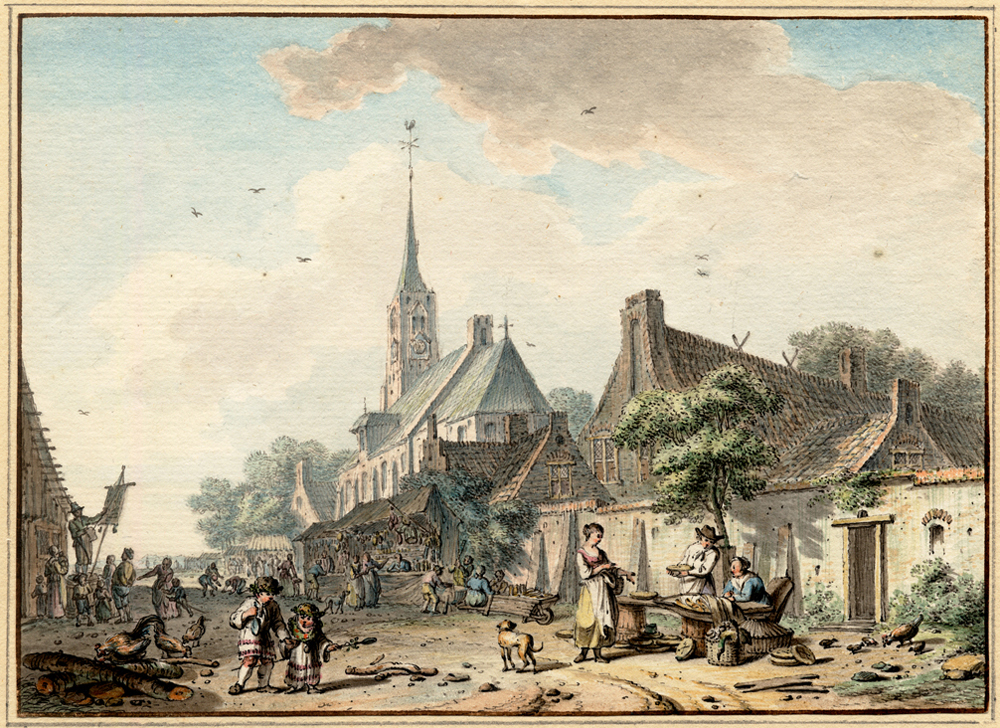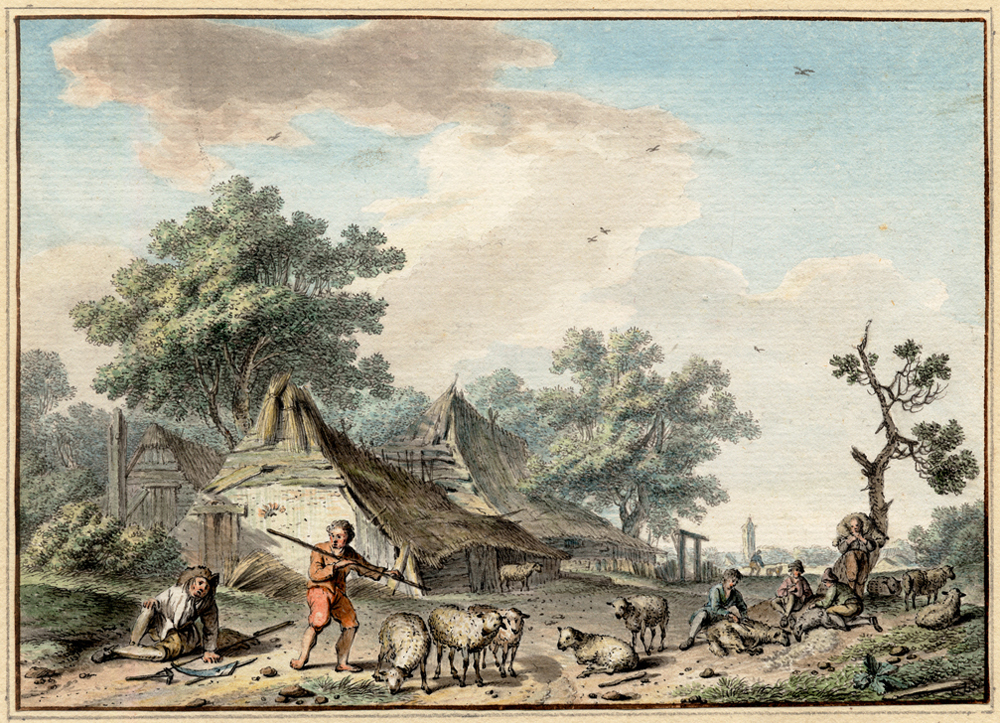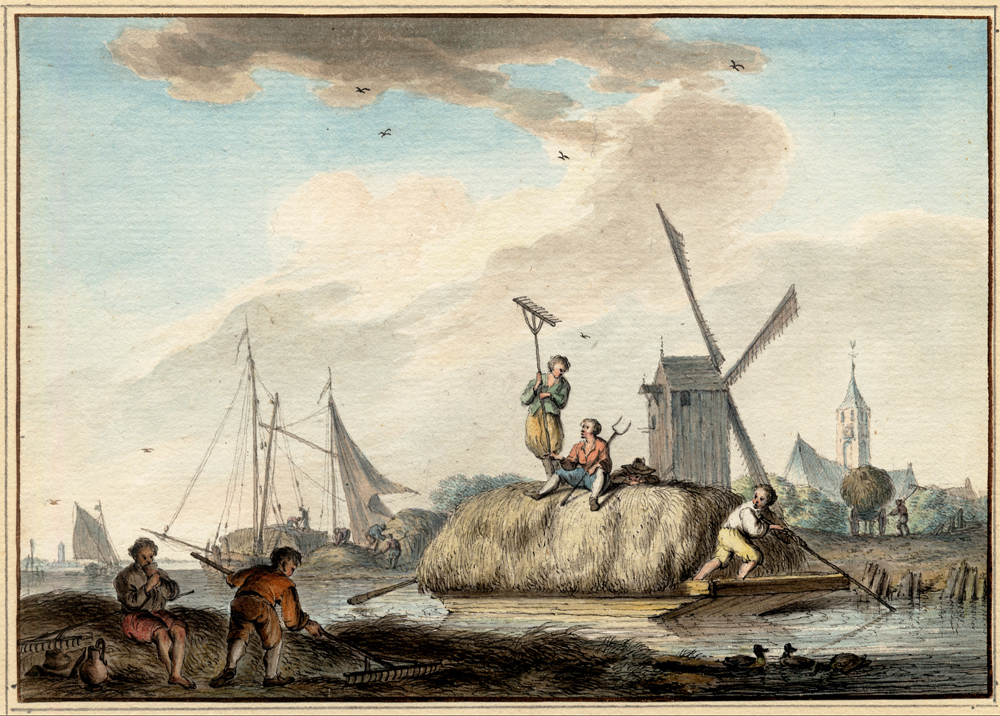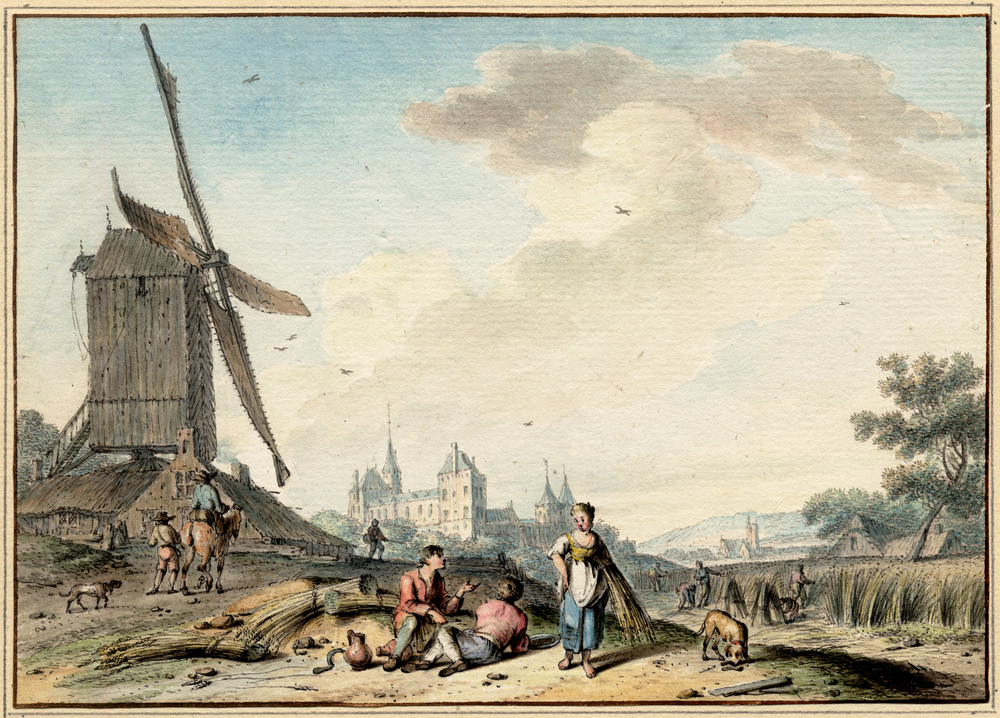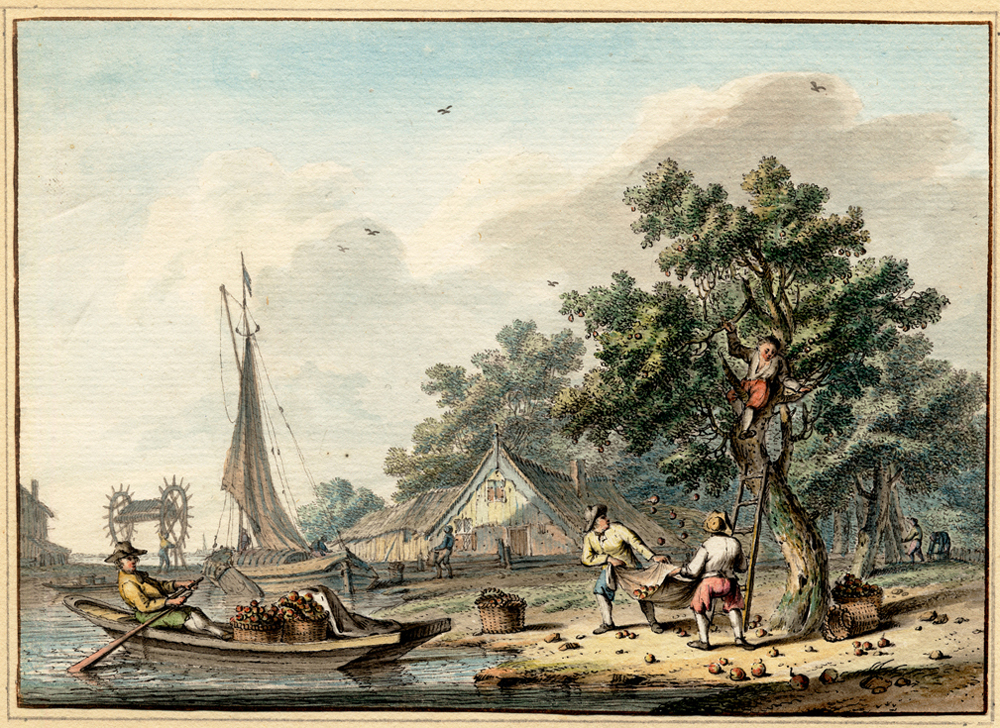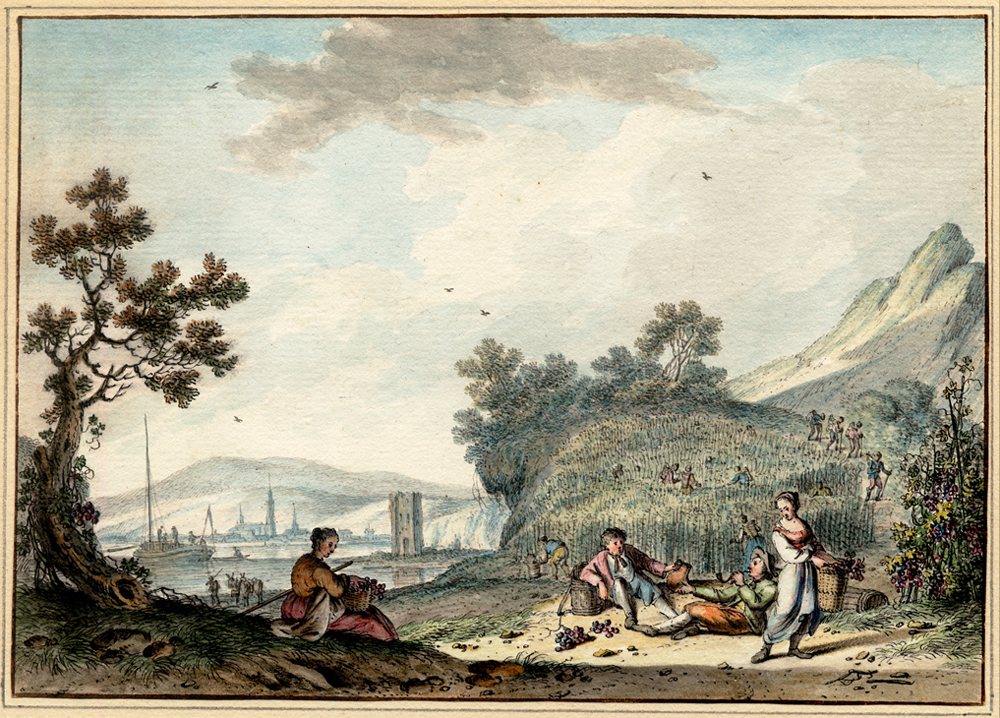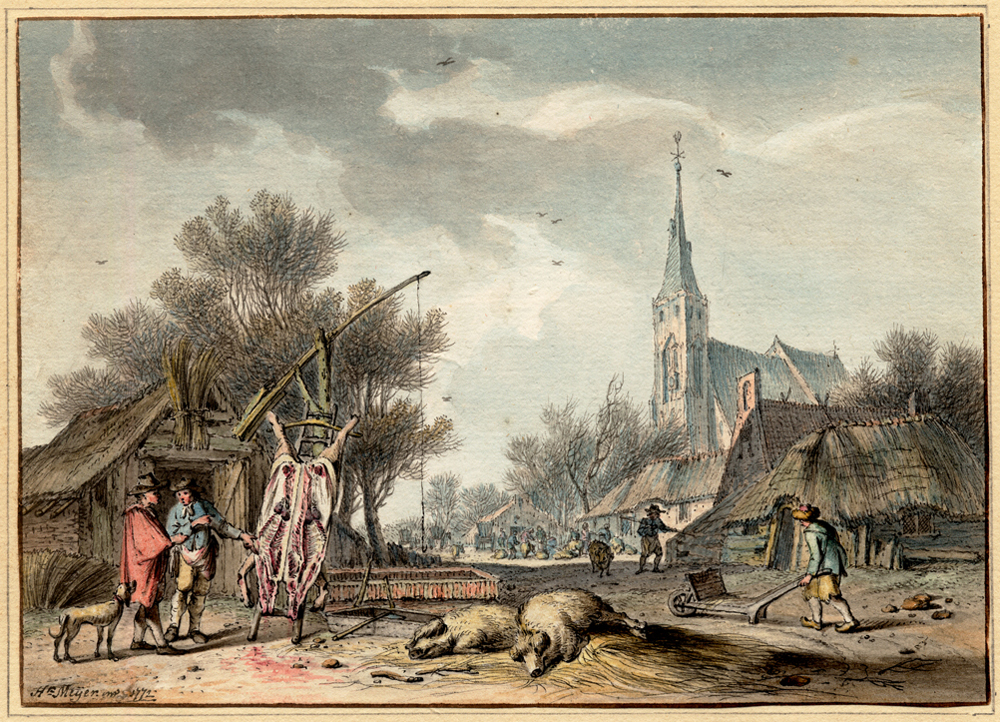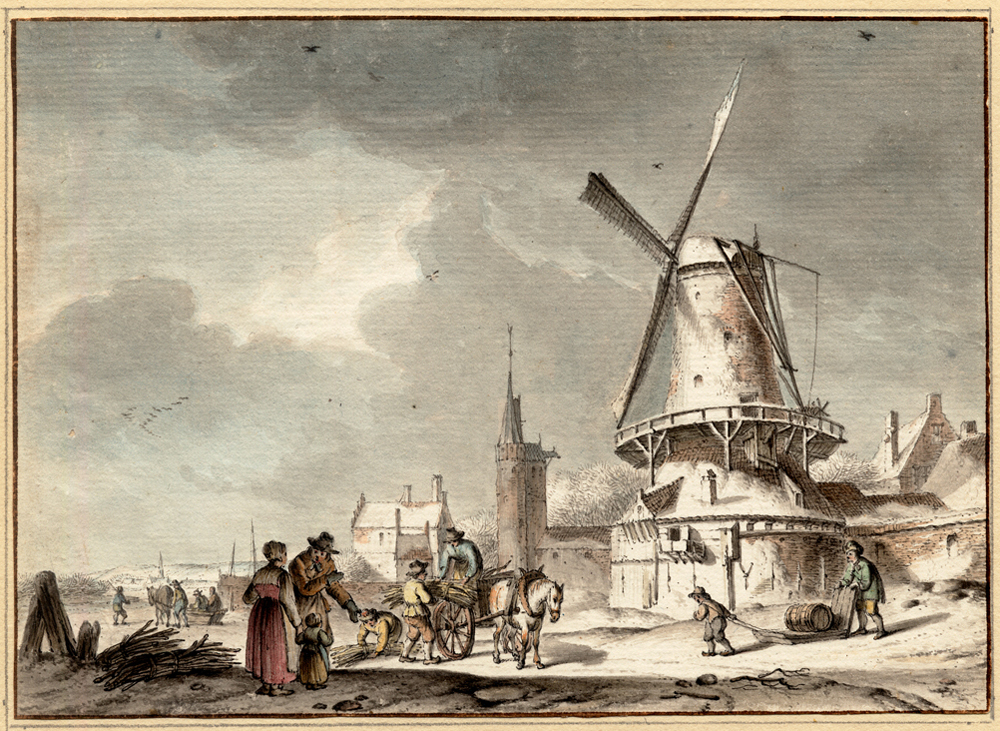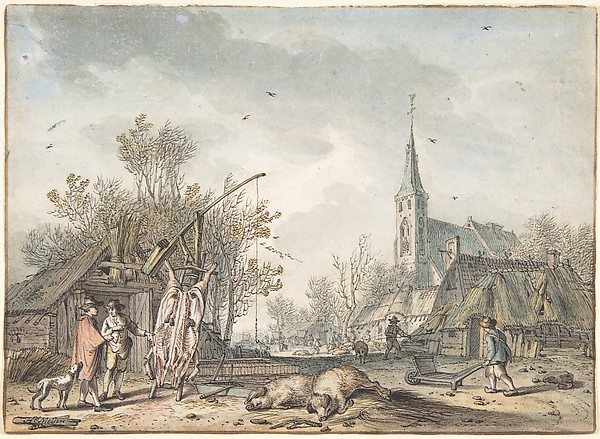HENDRIK DE MEIJER (Amsterdam 1744 – 1793 London)
Hendrik de Meijer (Amsterdam 1744 – 1793 London)
The Twelve Months of the Year
Pencil, pen in black and grey ink, watercolour and bodycolour on paper, brown ink framing lines, 131 x 185 mm (5.2 x 7.3 inch); hinged onto collector’s mounts with partial watermarks of ‘JH&Z’ (J. Honig & Zoon) of c. 1800 with framing lines in pencil and grey wash, 315 x 478 mm (12.4 x 18.8 inch)
January and November signed and dated ‘Hk. Meyer inv 1772’ (pen and black ink, lower left)
Provenance
~ Cornelis Ploos van Amstel (1726–1798), Amsterdam; his characteristic inscriptions ‘h. 5 ¼ d / b. 7 ¼ d' on the versos of all sheets (pen and brown ink) (Lugt 3004); his sale, Amsterdam (Van der Schley … Roos), 3 March 1800, Album H, no. 38: ‘Twaalf stuks, zynde de twaalf Maanden des Jaars; uitvoerig met de Pen en Sapverven, door H. Meyer.’ (‘Twelve pieces, being the twelve Months of the Year; elaborate with the Pen and Watercolours, by H. Meyer’), sold for fl. 71 to ‘Vollenhoven’.
~ Jacobus Vollenhoven, his sale, Amsterdam (De Vries … Roos), 11 February 1822, Album G, nos. 13-24: ‘De twaalf Maanden van het Jaar; zeer geestig en eigenaartig voorgesteld en rijk gestoffeerd door H. Meijer. NB Deze Teekeningen worden in eens verkocht.’ (The twelve Months of the Year; very amusing and characterfully depicted and richly embellished by H. Meijer. NB These Drawings will be sold in one.’)
~ Private collection, Belgium
***
Hendrik de Meijer was born in Amsterdam in 1744.1 He was first taught by the obscure artist David Coenraadts (c. 1713–1781), and subsequently attended the Amsterdam Drawing Academy or Stadstekenacademie from 1764 to 1768. In 1766 he married, became a citizen of Amsterdam, and soon thereafter joined the Guild of St Luke. In 1768 he moved to Haarlem and specialised in painted wall decorations, ‘behangsels’. In 1772, the year in which our series was executed, he became one of the founding directors of the Haarlem Drawing Academy, where he taught Cornelis Apostool, Jos van den Berg, Egbert van Drielst, Leendert Overbeek and Barend Hendrik Thier, among others.
In 1774 or 1775 he visited London with Wybrand Hendriks, another director of the academy. From 1775 to 1782 he worked in Leiden, and from 1782 to 1789 in Amsterdam, where he married a sister of the artist Daniël Dupré after the death of his first wife. In that year he moved to London, where he exhibited at the Royal Academy annually. He also made etchings combined with aquatint in London, a fashionable medium at the time. ‘Henry Meyer’, as he was known in England, lived at 34 Charles Street (Middlesex Hospital), when he died in 1793. Meijer’s estate was sold in London by the auctioneer Greenwood on 29-30 April of the same year.2 According to Christiaan Josi, a Dutch art dealer living in London at the time, Meijer’s work found a ready market there.3
As has been observed by Robert-Jan te Rijdt, Meijer had an instinct for what art lovers wished to collect. He often produced sets of watercolours or gouaches, of the Four Times of Day, the Four Seasons, pendants such as Summer and Winter, or Night and Day. The most elaborate of these series is doubtless the Twelve Months of the Year. The Months had a long tradition in the visual arts. Medieval book illuminators had already depicted them, but the earliest surviving independent set is by Hans Bol (1534–1593), made in 1580-81 as models for engravings, and now in the Boijmans Van Beuningen Museum, Rotterdam.4 The subject was especially popular during the 18th century, but due to the nature of these sets they were frequently split up and sold individually. Complete sets of the Months are known however by Simon Fokke (1765), Jacobus Buys (1771-73), H.P. Schouten (1789) and Jacob Cats (1791), while at least nine drawings from a series by Cornelis Troost of 1741 are known. Artists concentrated on different aspects of life: whereas Troost had a theatrical approach, Meijer focussed on rural and agricultural activities appropriate to each particular month.
January (Aquarius) or ‘snow month’ shows a frozen canal on the outskirts of a town with men and women skating and enjoying themselves; February (Pisces) or ‘rain month’ shows a rain-swept rural landscape with a windmill and labourers shovelling earth; March (Aries) or ‘spring month’ shows a view of a farmhouse with haystack and a oxen-drawn plough; April (Taurus) or ‘grass month’ shows a country church with a cattle on a ferry in the foreground; May (Gemini) or ‘bloom month’ shows a village street with a women selling vegetables and a peddler in the background; June (Cancer) or ‘summer month’ shows shepherds herding their flock on a sunny day; July (Leo) or ‘hay month’ shows recently harvested hay being ferried way; August (Virgo) or ‘harvest month’ shows wheat being harvested; September (Libra) or ‘autumn month’ shows a ‘Zaanse’ farmhouse with apples being gathered; October (Scorpio) or ‘wine month’ shows labourers resting after a day of picking grapes; November (Sagittarius) or ‘slaughter month’ shows recently killed pigs; December (Capricorn) or ‘winter month’ shows the outskirts of a town with wood being gathered to warm the chilly homes.
From references in early sale catalogues it is known that Meijer drew several series of Months. In addition to the present beautifully preserved set, only a single other series is known, in the Metropolitan Museum, New York.5 The Metropolitan Months are of almost identical composition to ours, differing only in minor details of architecture and figures, colouring and position of the birds. This Metropolitan set is also dated 1772, the same year as our series, and the two series were probably made alongside or shortly after each other – it is possible Meijer suspected a willing market for such an attractive series, or that a collector commissioned a duplicate set after having missed the possibility to acquire the first. Sheets from both the present and the Metropolitan set are annotated ‘inv.’, an abbreviation of ‘invenit’, meaning ‘invented’, to indicate that Meijer had designed the compositions himself. However because both sets bear this inscription, it is impossible to say which was executed earlier. In terms of execution, the present watercolours are of comparable quality to those in the Metropolitan, although in the New York sheets certain details have been excluded (for instance the pool of blood underneath the pig’s carcass in November). Our set is however far better preserved, with colours as fresh as when they were made, while the Metropolitan set appears rather discoloured, and the edges of most Metropolitan Months are damaged.
Many of the most celebrated collectors of the period owned sets of Months by De Meijer, including Theodorus van Duysel (d. 1784), Jan van Dijk (d. 1791) – who incidentally also owned Hans Bol’s set of Months now in Rotterdam –, Gerrit Willem van Oosten de Bruyn (1727–1797) and Cornelis Ploos van Amstel (1726–1798), who owned our series. Some of these collectors may have bought sets of Months in the sales of earlier collectors, but at least two original sets by Meijer must have existed, as Van Oosten de Bruyn’s set was sold in April 1800,6 while Ploos van Amstel’s set was sold only weeks before, in March of the same year.7 It is possible that Meijer also made a monochrome set in brown wash, as such a series is known from a sale catalogue of 1810.8 From other catalogues it is known that the Months were sometimes sold in six lots of two Months each, which may have been the fate of most series of this kind.
Highly finished coloured drawings such as the charming scenes of this rare series, almost like miniature paintings, were extremely fashionable during the eighteenth century. They were favoured by collectors of ‘papierconst’ (paper art), who kept them between the blank sheets of special collecting albums, away from the damaging influence of exposure to light. Because of this, they are often beautifully preserved, with their colours as fresh as the day they were painted, as is also the case with these twelve watercolours, which are superbly preserved.
1. He was not born in 1737 as was previously thought. For the artist, see: P.A.F. van de Kamp, Hendrik Meijer (1744-1793): leermeester & tekenaar, thesis, The Hague 2002.
2. Lugt 5047.
3. See Jane Shoaf Turner and Robert-Jan te Rijdt (eds.), Home and Abroad: Dutch and Flemish Landscape Drawings from the John and Marine van Vlissingen Art Foundation, exh. cat. Amsterdam (Rijksmuseum) and Paris (Fondation Custodia) 2015-16, p. 192.
4. Each 140 mm, circular; inv. nos. MB 2005/T 2 a-l (PK); see Albert J. Elen and Peter van der Coelen, Around the year with Bol: the twelve months drawn by Hans Bol in 1580-81, Rotterdam 2004.
5. All black chalk, black or grey ink and watercolour, c. 131 x 189 mm; signed and dated 1772; Metropolitan Museum of Art, New York, inv. no. 2005.249.1; they were previously with Sotheby’s, Amsterdam, 4 November 2003, lot 120, all repr.
6. Sale Gerrit Willem van Oosten de Bruyn, Haarlem (Van de Vinne), 8 April 1800, Album H, no. 11: ‘De 12 Maanden met Couleyren, door H. Meyer.’ (‘The 12 Months with Colours, by H. Meyer’).
7. Sale Cornelis Ploos van Amstel, Amsterdam (Van der Schley … Roos), 3 March 1800, Album H, no. 38: ‘Twaalf stuks, zynde de twaalf Maanden des Jaars; uitvoerig met de Pen en Sapverven, door H. Meyer.’ (‘Twelve pieces, being the twelve Months of the Year; elaborate with the Pen and Watercolours, by H. Meyer’), sold for fl. 71 to ‘Vollenhoven’.
8. Sale Johannes Ulricus van Heijnen and Jacob Helmolt, Amsterdam (Van der Schley … De Vries), 11 April 1810, Album I, no. 29: ‘Twaalf stuks, zijnde de Maanden des Jaars, eigenaardig voorgesteld. Meesterlijk met de pen en bruine inkt gewassen, door H. Meijer’ (‘Twelve pieces, being the Months of the Year, characteristically depicted. Masterly with the pen and washed with brown ink, by H. Meijer’), sold for fl. 10 to ‘Roos’).
